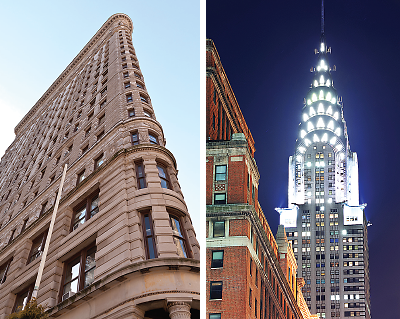Do you like buildings that are aesthetically daring? Do you have a good pair of walking shoes? If so, you should take time during APA’s annual meeting to view some of the Manhattan buildings that have achieved the status of architectural landmark.
The
Flatiron Building, at Fifth Avenue and 23rd Street, was completed in 1902. It is a vertical palazzo with Beaux-Arts (French Classical Renaissance) styling. Some think that it was the first building in Manhattan to have a steel structure, but dozens of steel-framed buildings had already been built in Manhattan during the 1890s. Nonetheless, because it boasts 22 stories, it qualified as Manhattan’s first skyscraper.
Grand Central Terminal, located at Park Avenue and 42nd Street, was completed in 1913. It is an engineering marvel because it provided innovative solutions to the challenge of accommodating a vast network of railroad lines and linking them up with New York City’s relatively new subway network. It is a distinguished piece of architecture in that it represents a Beaux-Arts monument to the golden age of railroads in the United States. The terminal’s façade consists of a symphony of arches filled in with steel and glass and topped by a gigantic clock. Inside, the Grand Concourse features lavish marble work and a domed ceiling with twinkling stars and is usually filled with bustling crowds.
The nearby
Chrysler Building, at 42nd Street and Lexington Avenue, is an Art Deco masterpiece and one of New York’s iconic images. Its steeple, formed by overlapping scales of gleaming steel with inset triangular windows, was designed to convey majesty and a sense of optimism. Inside, the building has 32 elevators, each inlaid with a different kind of wood from around the globe.
The
Empire State Building, at 34th Street and Fifth Avenue, was completed in 1931 and, like the Chrysler Building, was designed in Art Deco style, which was typical of pre-World War II architecture in New York. The building’s distinctive spire was originally designed to be a mooring mast and depot for dirigibles. Since 9/11, nearly all of New York City’s television and radio stations have transmitted from the top of the Empire State Building.
Rockefeller Center is a complex of buildings between 48th and 5lst streets and Fifth and Sixth avenues. Fourteen of the buildings were built in the 1930s and are considered Art Deco masterpieces.
Probably the most famous of these buildings is
Radio City Music Hall. When completed in 1932, it was promoted as the largest and most opulent theater in the world. In 1979, after decades as a premiere showcase for motion pictures and elaborate stage shows, the theater converted to presenting touring performers and special events. For example, a new show is arriving at the Music Hall this spring. It is called Heart and Lights and stars the famous Rockettes.
The
United Nations Headquarters, which extends from 42nd to 48th streets along First Avenue, was finished in 1953. The buildings represent Bauhaus or International Style—pure form without ornamentation.
Trump Tower, located at 56th Street and Fifth Avenue, made its debut in 1983. It is a 68-story bronze-colored glass skyscraper. Although the exterior may not be all that exceptional by Manhattan standards, the interior certainly is. A grand entrance leads to a seven-story pink-marble and bronze atrium, with a waterfall cascading down one of the walls. Visitors can ride crisscrossed escalators to the upper levels of the atrium, which contain elegant shops.
Following the destruction of the original World Trade Center on September 11, 2001, a new World Trade Center complex is in the process of being built in Lower Manhattan. The primary building is
One World Trade Center, located at 72 Vesey Street. The building’s design consists of simple symmetries and a rather traditional profile intended to fit into the contemporary New York skyline. The tower’s central spire, which gives the building the symbolic height of 1776 feet, shares some similarities with those of the Chrysler Building and Empire State Building and is reminiscent of the North Tower of the original World Trade Center. Much of the building is constructed from recycled materials. ■


